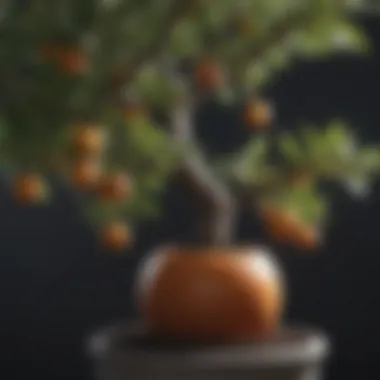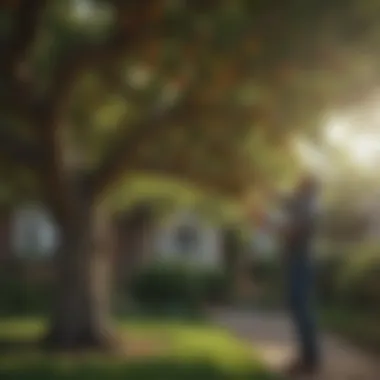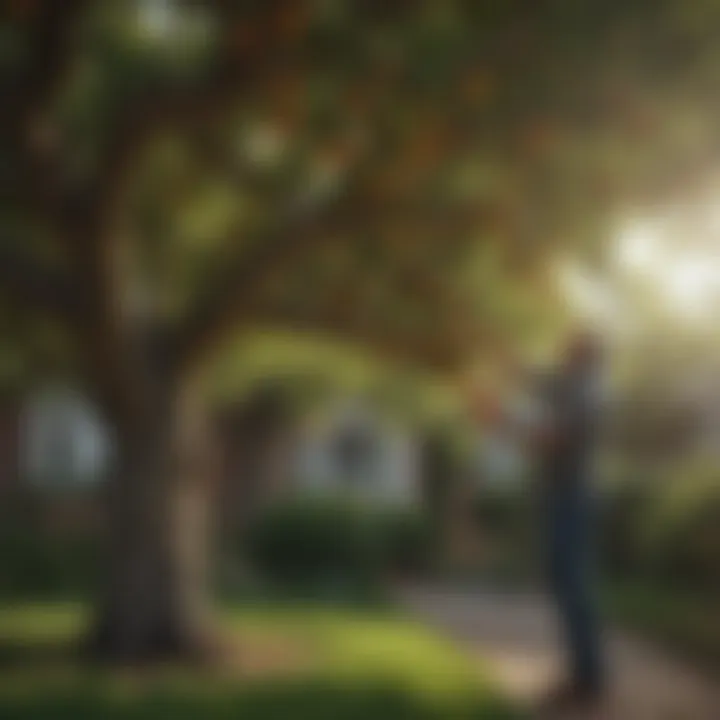Fruit Trees for Small Urban Gardens: A Practical Guide


Intro
Urban gardening is on the rise, especially as more people look to add a slice of nature to their tightly packed living spaces. One way to make the most of limited outdoor areas is by cultivating small fruit trees. These trees not only beautify the environment but also provide fresh produce right at your doorstep. Think about stepping out into your yard and plucking a ripe peach or a handful of cherries. Feels good, right?
Small fruit trees offer homeowners a practical solution to city living that’s as rewarding as it is sustainable. But there’s more to it than meets the eye. The selection process, the care of these plants, and the techniques involved in their upkeep can make or break your leafy endeavors. In this guide, we’ll explore the essential factors for successfully integrating fruit trees into urban gardens, touching on their benefits, optimal planting methods, and ongoing maintenance—all vital for ensuring your miniature orchard thrives.
"Gardening is a way of showing that you believe in tomorrow." – Unknown
By the end, you’ll have a rich tapestry of knowledge that prepares you not just for planting but for nurturing these living assets. Let's dig deeper into how you can turn each small yard into a vibrant patch of greenery.
Understanding the Appeal of Small Yard Fruit Trees
Urban gardens aren’t just a trend; they’re like little gold mines waiting to bloom. Those small patches of earth can pack quite a punch when it comes to sustainability, aesthetics, and delectability. The idea of cultivating small fruit trees is not just about planting some seeds and waiting for nature to take its course. It’s about enhancing your living space, boosting your quality of life, and having a tangible connection to the food that you consume. We dive deeper into why these trees are catching the urban gardener's eye and how they can transform otherwise overlooked areas into vibrant havens of productivity.
Benefits of Growing Fruit Trees in Limited Spaces
Growing fruit trees in a compact space may sound tricky, but the benefits are plenty. First off, these trees are often dwarf varieties, which are engineered to have a smaller footprint while still delivering that juicy, home-grown flavor. A few of the tantalizing reasons to consider them include:
- Fresh Produce: There’s just nothing that can compare to plucking a ripe fig or an apple straight from your backyard. The flavor is unparalleled.
- Aesthetic Appeal: Even when not in bloom, fruit trees add character. Their leaves and branches can create a lovely silhouette, contributing to your yard’s beauty.
- Environmental Benefits: Trees play a vital role in carbon absorption and oxygen production, helping to clean the urban air. Plus, flowering trees encourage bees and other pollinators, which are vital to our ecosystem.
- Sustainability Boost: In an age where convenience foods rule the roost, growing your own fruit can be a wonderful way to lessen your carbon footprint and make more sustainable choices.
By incorporating fruit trees into limited spaces, not only can you grow food, but you can also cultivate a garden that speaks to both your aesthetic sensibilities and your environmental values.
The Impact on Urban Living
Urban living can often feel restrictive. The hustle and bustle drains the joy from green spaces, but small yard fruit trees can tilt the scales back toward nature.
Imagine walking outside, the fresh morning air greeting you, and the first thing you notice is a blooming cherry tree. This change in environment can elevate your mood and provide a much-needed escape from the concrete jungle. In addition to personal joy, small fruit trees have a broader community impact:
- Community Engagement: Urban gardening fosters connections with neighbors, leading to community gardening groups where knowledge and produce can be shared.
- Educational Opportunities: These gardens can serve as real-life classrooms for children and adults alike, teaching them about sustainability and food origins.
- Food Security: Growing your own food can alleviate some reliance on grocery stores, especially in areas where fresh produce is sparse.
Selecting the Right Fruit Trees for Small Yards
Choosing the right fruit trees for your small yard isn't just a matter of picking what looks nice or what happened to be on sale at the local garden center. It's about understanding the limitations of your space and the potential benefits these trees can bring to your urban environment. Proper selection can lead to a fruitful harvest that not only nourishes your body but also enhances your garden's aesthetic appeal.
For urban gardeners, the right tree can fit seamlessly into limited spaces, making the most out of each square foot. Considerations like tree size, growth habits, and maintenance needs are crucial. If you get this part right, you can relish the delightful fruits your labor will yield.
Dwarf vs. Traditional Varieties
When it comes to picking fruit trees, the first big decision is often between dwarf and traditional varieties. Dwarf trees are like the little engines that could; they don’t take up much space but still deliver a hearty output. They typically max out at about 6 to 8 feet tall, perfect for gardens with low ceilings or cramped corners. Plus, their smaller stature makes pruning and harvesting a whole lot easier, ideal for those who might not have a green thumb or the sharpest ladders.
On the other hand, traditional trees can offer a more significant yield if you have the space. These trees can grow quite tall, reaching upwards of 20 feet, so they need room to spread their roots. However, the greater the tree, the more care it may require, including a reliable support system and possibly more pest management strategies. If you've got the yard to accommodate them, traditional varieties bring with them a sense of grandeur that can make you feel like you’ve secured a real piece of nature in the urban jungle.
Popular Small Yard Fruit Trees
Apple Trees
Apple trees are a classic option for many gardens. Their ability to produce a variety of apples means you can get everything from sweet to tart flavors all in one tree. Dwarf apple trees usually stay manageable in size and can thrive in containers, making them especially appealing for small spaces. Their blossoms in spring are stunning and attract pollinators, contributing to the overall health of your garden. One thing worth noting though is that different varieties require cross-pollination, meaning you may need more than one tree to ensure a robust harvest.
Pear Trees
Adding pear trees to the mix can offer a unique twist. They share many similarities with apple trees but tend to require slightly different care. Pear trees can be somewhat finicky about their environment, often preferring slightly richer soil. They’re also notable for their charming, fragrant blossoms. Keep in mind, some pear trees might be less resistant to pests, so you have to stay ahead in terms of prevention. However, if you’re after a lovely fruit that can add both visual and literal sweetness to your garden, these are a solid choice.
Cherry Trees
Cherry trees are fantastic not just for their fruits but also for their stunning visual appeal. Imagine a soft pink bloom, delicate and fragrant, bringing a pop of color to your urban landscape. Their fruit can be a delicious treat, either fresh off the limb or turned into desserts. But beware: many cherries require cross-pollination, so unless you want to play matchmaker for your trees, make sure to select compatible varieties.
Fig Trees


Figs are a bit of an unsung hero in small yard fruit tree gardening. They can be surprisingly tolerant of poor soil conditions and drought, which makes them low-maintenance. A fig tree can be grown in containers, and you’ll be rewarded with sweet, succulent fruits that are hard to replicate in a store. The primary downside is that some figs won't ripen in cooler climates, so you'd need to be aware of your local growing conditions.
Citrus Trees
Citrus trees are another favorite, as they add not only delightful fruit but also an alluring scent to your garden. Dwarf lemon or lime trees can thrive in pots, giving you the ability to move them around depending on the season or light conditions. Though popular, citrus trees demand good drainage and some attention to pests like aphids or spider mites. But once you harvest fresh lemons to squeeze into your drinks, it’ll all be worth it.
Climate Considerations
No matter how great your selected trees look on paper, real-world conditions will ultimately determine their success. Climate plays a pivotal role in the growth and yield of fruit trees. Different tree varieties have varying temperature ranges and chill hour requirements to produce hearty fruits.
For instance, if you live in a temperate zone, apple and pear trees often flourish well, but they may struggle in consistently hot, humid conditions. On the flip side, citrus trees might require warm days and cooler nights to develop the vibrant flavors we expect. Always check the specific needs of every variety—knowing your hardiness zone can save you a lot of heartache later on.
"The right tree in the right place can change the game for your urban garden."
Optimal Planting Techniques for Small Spaces
When it comes to cultivating small yard fruit trees, the right planting techniques can make a world of difference. Urban gardens, often confined and sometimes tricky, still hold great potential for lush and fruitful growth. By maximizing available space and ensuring the trees' needs are met, gardeners can reap a bountiful harvest. This section will explore three key areas: site selection and preparation, container gardening options, and spacing and arrangement strategies.
Site Selection and Preparation
Choosing the right spot for your fruit trees can significantly influence their growth. First off, observe your yard for sunlight—most fruit trees crave at least six hours of direct sunlight daily. Look for areas that are free from the shade of taller buildings or trees. Understanding your soil type also plays an essential role. Well-draining soil that’s rich in organic matter is ideal.
Before planting, it’s crucial to prepare the site. Remove any debris or weeds that might compete for nutrients. You might consider testing your soil’s pH. Most fruit trees thrive in a pH range of 6.0 to 7.0. If you're on the lower or higher end, adjusting it might be necessary. Adding compost or well-rotted manure can enhance the soil structure and enrich it with the necessary nutrients.
"A little prep work goes a long way in ensuring your fruit trees get off on the right foot."
Container Gardening Options
For those who truly pick strawberries in a tiny garden, container gardening is a game changer. Many dwarf fruit tree varieties adapt well to pots, making it possible to grow them on patios, balconies, or even rooftops. The size and type of the container can impact growth. A pot that is at least 18-24 inches in diameter allows enough room for roots to spread.
When choosing containers, ensure they have good drainage to avoid waterlogging. Using a high-quality potting mix is also essential, as it provides a balanced environment for the trees to thrive. Keep in mind that container trees may need more water than those planted in the ground, as pots tend to dry out faster. Regular monitoring is key to ensuring that your container garden remains hydrated.
Spacing and Arrangement Strategies
In a small yard, every inch counts. Thus, thoughtful spacing and arrangement strategies are vital for maximizing sunlight and air circulation. When planting in the ground, rule of thumb is to space dwarf fruit trees about 4 to 6 feet apart. This distance can vary based on the mature size of the specific tree, but crowding them can result in a struggle for resources.
Also, consider vertical space—utilize trellises or vertical planters for certain varieties like climbing berries or espaliered trees. This not only adds an element of design but also optimizes the available growing area. Aligning your trees to complement the aesthetic flow of your garden can transform an ordinary space into a cohesive landscape.
Caring for Small Fruit Trees
Caring for small fruit trees is not just about watering and waiting. It’s a multifaceted endeavor that transforms your urban garden into a lush oasis. When living in a confined space, every bit of effort counts, and nurturing these trees can lead to a bountiful harvest that rewards your dedication. To have thriving fruit trees, it's vital to understand their basic needs—like water, nutrients, pruning methods, and pest management. Each of these elements plays a role in not only promoting healthy growth but also ensuring that your small yard plays host to vibrant, productive trees.
Watering and Nutritional Needs
Watering turns out to be a critical factor for the health of your small fruit trees. These trees might be smaller in size, but they still require a good amount of hydration to produce luscious fruits. It’s important to establish a routine that aligns with the tree species and your local climate. Generally, young trees need more frequent watering to help them establish strong root systems. In contrast, mature trees may only need watering when there is a notable lack of rainfall.
Moreover, considering the soil quality is key. Nutrient-rich soil enhances the growth rate and fruit yield. Soil testing for pH levels and nutrients can help you identify deficiencies. You can enhance the soil by including organic matter such as compost or well-rotted manure, which not only feeds the tree but also improves the soil structure.
Pruning Techniques for Enhanced Production
Pruning might sound tedious, but it is one of the best favors you can do for your small fruit trees. By removing dead, damaged, or overcrowded branches, you help the tree focus its energy on producing fruit. Pruning encourages a more open shape, allowing sunlight into the center of the tree, which is essential for fruit development.
Another important aspect is the timing. Ideally, late winter to early spring is the right moment for pruning, right before the tree begins its growing season. Each fruit tree species may have specific pruning requirements, so do your research to ensure cuttings promote growth rather than hinder it.
Pest and Disease Management
Keeping your fruit trees healthy requires vigilance against pests and diseases. Unfortunately, urban locations can increase exposure to common garden nuisances.
Common Pests and Organic Solutions


In the realm of pest management, knowing what you’re up against is half the battle. Aphids, spider mites, and fruit flies are some common pests that can wreak havoc on your trees. The good news? There are organic solutions that effectively manage these issues while keeping your garden eco-friendly. For example, introducing beneficial insects like ladybugs can drastically reduce aphid populations without resorting to harmful chemicals.
Implementing integrated pest management (IPM) strategies ensures your small fruit trees thrive without toxic substances affecting the ecosystem around them.
One characteristic of organic solutions is their safety—both for you and the environment. However, this may require consistent monitoring and a bit more effort than conventional pesticides, which may show rapid results but have more severe long-term repercussions.
Identifying Diseases and Remedies
Identifying diseases early on can turn the tide in protecting your small fruit trees. Conditions such as powdery mildew or root rot can emerge unnoticed. Monitoring symptoms like yellowing leaves or unusual drooping can provide clues to underlying issues.
Using disease-resistant varieties can be advantageous, but understanding how to manage these diseases is equally crucial. Sanitation is one of the key characteristics in disease management. Regularly cleaning fallen debris and ensuring good air circulation around trees helps prevent issues from spreading.
Organic remedies like neem oil or baking soda sprays can be effective for common ailments while steering clear of chemical concoctions that alter soil balance. Continuous education on your trees’ needs and potential threats will make a significant impact on their longevity.
In summary, caring for fruit trees involves a blend of knowledge and consistent practices, focusing on sustenance, growth, and protection. Each small step contributes to a delightful harvest, creating not just tasty fruit but a thriving green corner in your urban setting.
Maximizing Yield from Your Fruit Trees
Maximizing yield from your fruit trees is a cornerstone of urban gardening, especially when space is at a premium. The idea is to not only grow fruit but also to make the best use of every square foot. Having fruit trees in small yards can seem challenging, but with some clever strategies, you can fill your basket to brimming without feeling cramped.
The benefits of maximizing yield are twofold: it enhances your gardening experience by providing bountiful harvests while also contributing to food sustainability. Growing your own fruits allows you to rely less on store-bought options, which often come with higher environmental costs. In an urban setting, where community gardens and green spaces might be scarce, turning your small yard into a productive oasis speaks volumes about resilience and innovation.
"The smallest spaces can yield the biggest rewards, if tended to with care and strategy."
Pollination Strategies
For fruit trees to bear good fruit, effective pollination is key. Unlike large orchards with natural pollinators flitting about, urban environments can present challenges. Here are some strategies to consider:
- Plant Multiple Varieties: Some trees benefit from cross-pollination. For instance, if you're growing apple tree types, having at least one different variety can increase yields.
- Attract Pollinators: Cultivating flowers nearby can draw in bees and other pollinators. Plants like lavender, sunflowers, and bee balm are excellent companions.
- Hand Pollination: If nature’s pollinators are scarce, using a small brush or even your finger to transfer pollen between flowers can get the job done.
By employing these techniques, you're not just helping your trees bear more fruit; you're also creating a micro-ecosystem that supports local biodiversity.
Harvesting Techniques
Successfully reaping the fruits of your labor involves more than just picking the trees clean. Knowing how and when to harvest can be the difference between a delightful treat and a disappointing bust. Here’s a rundown:
- Timing is Everything: Each fruit has its peak season. Knowing when to pick can vastly improve taste and texture. General rule of thumb: if the fruit comes off the tree easily, it's ripe.
- Use Proper Tools: Employing sharp pruning shears can prevent damage. If the fruit is high, a fruit picker with an extendable pole can keep your feet on the ground.
- Gentle Handling: Treat your fruit with care to avoid bruising. Collect them in soft containers; a sturdy basket works far better than a plastic bag.
With the right timing and technique, you will see your yield climb, making you feel like a modern-day Johnny Appleseed.
Storing and Preserving Your Harvest
Once you’ve gathered a bountiful harvest, preserving your hard work is next on the agenda. Although fresh is best, sometimes you simply can't eat it all at once. Here are strategies to extend the life of your fruit:
- Canning: Fill jars with your fruit and preserve them for future use. This method works particularly well for jams, jellies, and canned fruit.
- Freezing: For fruits like berries and peaches, freezing can maintain flavor while stashing away for smoothies or baked goods later on. Just wash, chop, and freeze them in single layers before transferring to bags.
- Dehydration: Drying your fruit is another tasty alternative. Not only does it increase shelf life, but dried fruits make excellent snacks—just think about those figs and apples.
By efficiently storing and preserving your fruit, you’re ensuring that not only does your labor bear fruit, but it continues to satisfy your palate long after you've gathered.
Maximizing yield with thoughtful strategies lays the groundwork for a rewarding gardening experience. Every harvest becomes not just a simple activity but a testament to your skill and dedication to urban living.
Designing an Aesthetic Layout for Your Garden
Creating an inviting and visually appealing garden is just as important as cultivating healthy fruit trees. In limited urban spaces, the layout you design can transform a mundane plot into a vibrant sanctuary. This aesthetic not only uplifts the space but also adds value to your property and enhances your enjoyment of your garden. Engaging with your outdoor area through careful design elevates the act of gardening from a chore into a fulfilling, artistic endeavor.
Aesthetic layout grows familiarity with your plants. When you intersperse colors, textures, and shapes, your garden will reflect the seasons and bring joy year-round. Moreover, a well-planned arrangement can improve practical aspects such as sunlight and airflow, leading to healthier trees and higher yields of fruit.
Combining Flowering Plants with Fruit Trees


Integrating flowering plants with your fruit trees is akin to an artist mixing shades on a palette. The right combination can enhance the beauty of your garden while contributing to a healthier ecosystem. For instance, planting marigolds near your fruit trees may deter pests, while attracting beneficial insects such as ladybugs. These little helpers can keep the harmful ones at bay, allowing your trees to thrive.
When selecting flowering companions, consider the color palette and bloom timing:
- Spring Blossoms: Plant daffodils and tulips to welcome brighter days.
- Summer Friends: Sunflowers can provide a bold statement against the lush green of your trees.
- Fall Foliage: Asters and chrysanthemums bring cheer as summer bids farewell.
The end result? A garden that feels alive with movement and vitality, created by the harmony of color and the balance of nature. It’s almost poetic to watch how the flowers bloom alongside your fruit trees, making the garden an experience, not just a place.
Creating a Cohesive Garden Theme
A cohesive garden theme turns your space into a narrative. When all elements work together, the garden transforms into a larger story that echoes your personal taste. A well-defined theme can give your garden an identity, pulling together various elements through color, style, or even a particular style of planting.
To cultivate such a theme, you might consider:
- Color Schemes: Choose a palette that aligns with your other garden features, perhaps focusing on earthy tones that complement the rich greens of foliage.
- Materials: If your garden pathway is of natural stone, consider selecting pots or trellises made from similar materials.
- Species Selection: As mentioned, if you go with vibrant flowers, matching fruit-bearing trees, such as cherry or apple, will relate visually and thematically as they both offer seasonal beauty.
Using these strategies, your garden will not just be a collection of plants and trees; it will be a curated experience. One where every corner invites exploration, and every bloom tells a part of your story. You can create a space that, besides being productive, is also visually cohesive and respected in your neighborhood.
A well-designed garden layout can serve as both a feast for the eyes and a fruitful source of nourishment.
Ultimately, attention to aesthetics in your urban garden fosters a nourishing environment not just for your fruit trees, but for your wellbeing and pleasure. By combining flowering plants and crafting a cohesive theme, you turn a small yard into a personal oasis — a patch of nature tucked away among the city hustle.
Sustainable Practices in Fruit Tree Gardening
In the realm of urban gardening, cultivating small fruit trees goes hand-in-hand with sustainable practices. This is particularly crucial as city dwellers grapple with the dual challenges of limited green space and the pressing need for environmental stewardship. By embracing sustainability in the care of fruit trees, not only can homeowners enjoy fresh produce, but they can also contribute positively to their local ecosystems.
Importance of Sustainable Practices
Adopting sustainable practices in fruit tree gardening means making choices that enhance the health of the soil, conserve water, and reduce the need for chemical pesticides. For those tending to small urban gardens, this approach becomes a vital element in ensuring long-term productivity and environmental harmony. Sustainable gardening not only yields healthier fruits but also cultivates biodiversity, providing habitats for beneficial insects and birds, vital for pollination.
"A garden is not just a collection of plants; it is a living ecosystem that supports life in myriad forms."
Organic Gardening Techniques
Organic gardening techniques play a significant role in sustainable practices for urban fruit trees. Here are a few effective strategies:
- Natural Fertilizers: Using compost or organic fertilizers enriches the soil without introducing harmful chemicals. Kitchen scraps can often be turned into nutrient-rich compost, making for a sustainable cycle.
- Crop Rotation: Introduce a system of rotating plants. This helps prevent soil depletion and reduces the risk of pest infestations, creating a healthier planting environment.
- Mulching: Applying organic mulch around the base of fruit trees helps retain moisture and suppress weeds. It contributes to soil health while reducing the need for frequent watering.
- Pest Control: Instead of chemical sprays, consider introducing predatory insects like ladybugs or using neem oil to combat pests. These organic solutions can be just as effective while keeping the garden environment safe.
Using these techniques not only supports the well-being of your fruit trees but also aligns with a philosophy of respect for the planet.
Companion Planting Benefits
Companion planting is another robust strategy that complements sustainable practices in fruit tree gardening. It revolves around the idea of pairing beneficial plants together, maximizing the health of your garden:
- Improved Soil Health: Certain plants, like legumes, can enrich the soil with nitrogen, providing essential nutrients to fruit trees. Additionally, they can improve soil structure.
- Pest Management: Plants like marigolds are known for repelling harmful insects. Planting them alongside fruit trees creates a natural barrier against pests.
- Pollinator Attraction: Incorporating flowering plants can attract bees and other pollinators, which is essential for fruit production. More pollinators mean more fruits come harvest time.
- Microclimate Creation: Companion plants can offer shade and protection for smaller fruit trees, helping them manage temperature extremes and retain moisture.
Resources for Further Exploration
In an era where urban spaces become increasingly limited, homeowners seeking to cultivate small yard fruit trees must consider not only what to plant but also how to educate themselves and connect with others in the gardening community. This section delves into valuable resources that can elevate your gardening experience, broadening your knowledge and providing support when needed. From insightful literature to local networks, the right resources can make all the difference in ensuring your small fruit orchard thrives.
Books and Online Guides
When it comes to deepening your understanding of fruit trees suitable for small yards, reliable literature is worth its weight in gold. There are numerous books and online guides that comprehensively tackle the topic, from selecting the right varieties to ongoing care strategies.
- Books: Look for titles that focus explicitly on small-space gardening or urban fruit trees. Books such as "Veggie Garden Remix" by "Niki Jabbour" explore innovative methods to maximize your limited outdoor area. Another valuable resource is "The Backyard Orchardist" by "Phillip R. Preedy," which touches on techniques specifically suited for smaller plots.
- Online Guides: Websites like Wikipedia and Britannica provide a wealth of information about different fruit species, their needs, and how to care for them. Gardening forums on Reddit can be particularly helpful. Here, real gardeners share their experiences and insights, helping newcomers learn from the triumphs and pitfalls of others.
Reading these materials will not only help you choose the right trees but will also equip you with practical skills to maintain them effectively.
Local Gardening Communities and Workshops
Getting involved in local gardening communities offers both knowledge and companionship. These networks provide invaluable support, particularly for novice gardeners who might feel overwhelmed. Being part of a community fosters shared growth, where both successes and challenges can be discussed openly.
- Community Groups: Many local gardening clubs hold regular meet-ups or workshops. These events are excellent opportunities for hands-on learning. Sometimes you can even find group buying deals on soil, fertilizers, and other gardening supplies.
- Workshops: Look for workshops in your area, perhaps at botanical gardens or community centers. Topics range from basic gardening techniques to advanced pruning methods, making them suitable for gardeners of all skill levels. Many offer the chance to learn directly from seasoned professionals. Not only can these workshops teach vital skills, but they can also act as a springboard for networking within the gardening community.
Engaging with others who share your passion helps build a supportive environment where everyone's input is valued. Collaboration can lead to creative ideas and solutions that might not come to mind alone.



